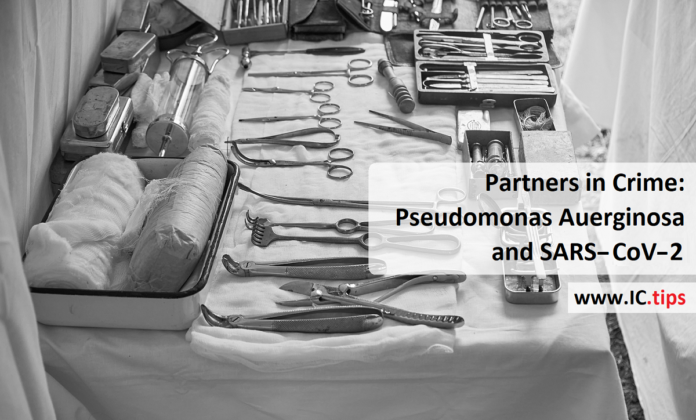The year was 1882 and a French chemist and biologist named Carle Gessard discovered an unusual bacterium that stained the bandages of French soldiers with a beautiful bluish green colour (Moore, 2011). It would take another 12 years before Walter Migula proposed a name, suggesting the genus Pseudomonas, which comes from the Greek word meaning “false unit”. He described his findings as “cells with polar organs of motility” (Etymologia, 2012). The genus was divided into five categories and aeruginosa comes from the Latin “veridigris” for the green colour that Gessard had noted (Cascella, 2022).
How can anything that looks so graceful, be bad?
For anyone who has seen P. aeruginosa under a microscope, you cannot help but be mesmerized by the dance like quality of its movements. How can anything that looks so graceful, be bad? One needs to only walk through the halls of an ICU anywhere in the world to understand how deceivingly dangerous this clever microbe is.
P. aeruginosa lives in soil, so it would make sense that flesh wounds on soldiers who are forced to suffer under the outdoor elements of war would be exposed to this bacterium (Etymologia, 2012). It is still somewhat of a mystery how consistently P. aeruginosa finds its way into the lungs of patients on a ventilator. In fact, study after study has shown key risk factors for developing ventilator associated pneumonia with P. aeruginosa include prior antibiotic exposure, history of COPD and greater than five days of mechanical ventilation (Ramfirez-Estrada, 2016). Many theories have been proposed, but perhaps the most plausible is that many healthy individuals are colonized by P. aeruginosa. The bacterium stays dormant in those who are healthy, and the immunocompromised state of critical illness brings down the host’s defenses, allowing for the bacteria to thrive and disseminate (Ramfirez-Estrada, 2016).
In December 2019 at the early days of the pandemic, the world was waking up to the alarm bells being sounded by the WHO regarding COVID-19. Already in China, tens of thousands of people were in hospital with many in the ICU requiring ventilator support. Those immunocompromised or with serious underlying respiratory complications were at far greater risk of serious complications (Cascella, 2022).
The challenges of treating these patients are multifactorial. Space within hospitals and availability of ICU beds is one logistical challenge, but what is often overlooked is that hospitalizing a patient with SARS-CoV-2 can increase their risk of mortality, because of exposure to opportunistic bacterial infections within a hospital environment. Some of this interplay between the bacteria and virus can lead to a synergistic advantage for both microbes and there is an increasing body of evidence that supports this. P. aeruginosa can positively modulate SARS-CoV-2 infectivity in the respiratory epithelium of patients by increasing TMPRSS2 expression, thereby increasing entry into the cells of both the bacteria and the virus, especially in the lungs of patients with cystic fibrosis who are at greater risk of complications with SARS-CoV-2 (Ruffin, 2021).
It is difficult to quantify the number of lives lost globally because of these co-infections or superinfections. I suspect that for decades to come, researchers and epidemiologist will be pouring over the data and trying to understand the full impact on loss of human life (Mirzaei, 2020). It cannot be stated enough that these co-infections put clinicians between a rock and hard place. On one hand, treating with broad-spectrum antibiotics early can decrease the risk of more severe disseminated infection, however this approach does increase the risk of antibiotic resistance, which is increasingly becoming a healthcare emergency (Dexter, 2020).
A call to action was issued for the world and the scientific community in 2020 to develop therapies that prevented and treated SARS-CoV-2. The world answered the call. During the last two years of the pandemic there has been unprecedented advancements in vaccines and therapeutic options for COVID-19. In 2017 the WHO had issued a similar call to action regarding P. aeruginosa, and the increasing prevalence of antibiotic resistant strains. There was an urgency to develop novel treatments (Botelho, 2019). Sadly, over 5 years later, this call has not been answered.
References
Botelho J, Grosso F, Peixe L. Antibiotic resistance in Pseudomonas aeruginosa – Mechanisms, epidemiology and evolution. Drug Resist Updat. 2019 May;44:100640. doi: 10.1016/j.drup.2019.07.002. Epub 2019 Jul 19. PMID: 31492517
Cascella M, Rajnik M, Aleem A, Dulebohn SC, Di Napoli R. Features, Evaluation, and Treatment of Coronavirus (COVID-19). 2022 Oct 13. In: StatPearls [Internet]. Treasure Island (FL): StatPearls Publishing; 2022 Jan–. PMID: 32150360.
Dexter F, Parra MC, Brown JR, Loftus RW. Perioperative COVID-19 Defense: An Evidence-Based Approach for Optimization of Infection Control and Operating Room Management. Anesth Analg. 2020 Jul;131(1):37-42. doi: 10.1213/ANE.0000000000004829. PMID: 32217947; PMCID: PMC7172574.
Etymologia: Pseudomonas. Emerg Infect Dis. 2012 Aug;18(8):1241. doi: 10.3201/eid1808.ET1808. PMCID: PMC3423701.
Mirzaei R, Goodarzi P, Asadi M, Soltani A, Aljanabi HAA, Jeda AS, Dashtbin S, Jalalifar S, Mohammadzadeh R, Teimoori A, Tari K, Salari M, Ghiasvand S, Kazemi S, Yousefimashouf R, Keyvani H, Karampoor S. Bacterial co-infections with SARS-CoV-2. IUBMB Life. 2020 Oct;72(10):2097-2111. doi:
Moore, Nicholas M., Maribeth L. Flaws American Society for Clinical Laboratory Science Jan 2011, 24 (1) 41-42; DOI: 10.29074/ascls.24.1.41
Ramírez-Estrada S, Borgatta B, Rello J. Pseudomonas aeruginosa ventilator-associated pneumonia management. Infect Drug Resist. 2016 Jan 20;9:7-18. doi: 10.2147/IDR.S50669. PMID: 26855594; PMCID: PMC4725638.
Ruffin M, Bigot J, Calmel C, Mercier J, Givelet M, Oliva J, Pizzorno A, Rosa-Calatrava M, Corvol H, Balloy V, Terrier O and Guillot L (2021) Flagellin From Pseudomonas aeruginosa Modulates SARS-CoV-2 Infectivity in Cystic Fibrosis Airway Epithelial Cells by Increasing TMPRSS2 Expression. Front. Immunol. 12:714027. doi: 10.3389/fimmu.2021.714027












